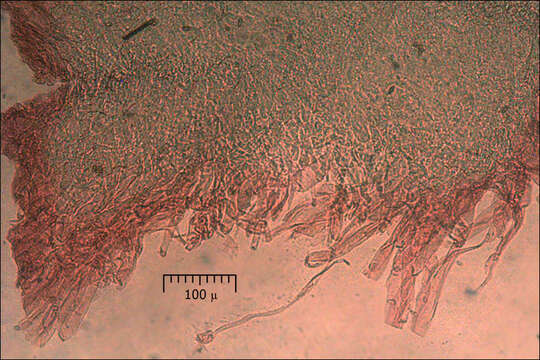Hemileccinum-impolitum-cutis_3M

Description:
Hemileccinum impolitum (Fr.) utara, syn: Boletus impolitus Fr., Leccinum impolitum (Fr.) Bertault, Xerocomus impolitus (Fr.) Qul. EN: Iodine Boletus, DE: Fahler RhrlingSlo.: preprosti gobanDat.: Sept. 19. 2018Lat.: 46.360465 Long.: 13.693133Code: Bot_1157/2018_DSC3305Habitat: old stands of Fagus sylvatica wood with scattered Picea abies, no Quercus sp. in the vicinity; steep mountain slope, southeast aspect; calcareous ground; shallow, skeletal, presumably locally somewhat acid soil (growing among Erica carnea), no clay present; half shade; dry and relatively warm place; partly protected from direct rain by tree canopies; average precipitations ~ 3.000 mm/year, average temperature 5-7 deg C, elevation 885 m (2.900 feet), alpine phytogeographical region.Substratum: soil. Place: Lower Trenta valley, between villages Soa and Trenta, right bank of river Soa; next to the trail from Soa 46 abandoned farm house to Planina Na skalah, just before the trail passes a sandy ravine, East Julian Alps, Posoje, Slovenia EC.Comments: Hemileccinum impolitum is a beautiful, all yellowish bolete, generally considered a rare find in Europe. However, this doesn't seem to hold for Slovenia, since many records exist in Boletus Informaticus Data Base (Ref.7). The species is very similar to closely related Hemileccinum depilatum (Redeuilh) utara. The most important distinguishing traits are pilei surface and microscopic structure of pilei cutis. The latter species usually looks like having 'hammered' pileus. However, the only sure way to differentiate them is microscopic structure of their pilei cuticle. Hemileccinum depilatum has hymeniform-cellular cuticle with many club shaped to sub globose end cells. I found nothing like this in this find. Growing solitary. Hut diameter 12 cm, stipe 12.5 cm long and almost 4 cm wide (max); hut somewhat sticky; strong smell on chemicals in the stipe base (which almost disappears after several hours), otherwise smell of trama and pore layer quite mild; taste mild, pleasant; no part of the pileus is bruising when cut or damaged; SP abundant, olive-beige, oac847. Spores smooth. Dimensions: (11.5) 12.1 - 13.9 (14.5) (5.1) 5.3 - 5.8 (6.1) m, Q = (2) 2.2 - 2.5 (2.7); N = 33; Me = 13 5.5 m; Qe = 2.3; Olympus CH20, NEA 100x/1.25, magnification 1.000 x, oil in water, fresh material. AmScope MA500 digital camera.Herbarium: Mycotheca and Herbarium of Slovenian Forestry Institute, Vena pot 2, Ljubljana, Slovenia, Index Herbariorum acronym LJFRef.: (1) boletales.com/genera/boletus/b-impolitus/ (accessed Sept. 20. 2018) (2) J. Breitenbach, F. Kraenzlin, Eds., Fungi of Switzerland, Vol.3. Verlag Mykologia (1991), p 56. (3) G.J. Krieglsteiner (Hrsg.), Die Grosspilze Baden-Wrttembergs, Band 2., Ulmer (2000), p 226. (4) M. Bon, Parey's Buch der Pilze, Kosmos (2005), p 36. (5) www.gobe.si/Gobe/BoletusImpolitus (accessed Sept. 22. 2018)(6) R. Phillips, Mushrooms, Macmillan (2006), p 278. www.zdravgozd.si/bi_index.aspx (accessed Sept. 22. 2018)
Included On The Following Pages:
This image is not featured in any collections.
Source Information
- license
- cc-by-nc-sa
- copyright
- Amadej Trnkoczy
- photographer
- Amadej Trnkoczy
- original
- original media file
- visit source
- partner site
- Flickr Group
- ID


